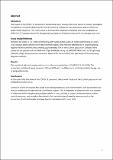Files in this item
Enhanced surveillance of COVID-19 in Scotland : population-based seroprevalence surveillance for SARS-CoV-2 during the first wave of the epidemic
Item metadata
| dc.contributor.author | Dickson, E | |
| dc.contributor.author | Palmateer, N E | |
| dc.contributor.author | Murray, J | |
| dc.contributor.author | Robertson, C | |
| dc.contributor.author | Waugh, C | |
| dc.contributor.author | Wallace, L A | |
| dc.contributor.author | Mathie, L | |
| dc.contributor.author | Heatlie, K | |
| dc.contributor.author | Mavin, S | |
| dc.contributor.author | Gousias, P | |
| dc.contributor.author | Von Wissman, B | |
| dc.contributor.author | Goldberg, D J | |
| dc.contributor.author | McAuley, A | |
| dc.date.accessioned | 2022-09-28T11:30:13Z | |
| dc.date.available | 2022-09-28T11:30:13Z | |
| dc.date.issued | 2021-01 | |
| dc.identifier | 280689617 | |
| dc.identifier | fed28d3a-fcd1-4b5a-82b3-ffe21af9aab2 | |
| dc.identifier | 33453689 | |
| dc.identifier | 85099205801 | |
| dc.identifier.citation | Dickson , E , Palmateer , N E , Murray , J , Robertson , C , Waugh , C , Wallace , L A , Mathie , L , Heatlie , K , Mavin , S , Gousias , P , Von Wissman , B , Goldberg , D J & McAuley , A 2021 , ' Enhanced surveillance of COVID-19 in Scotland : population-based seroprevalence surveillance for SARS-CoV-2 during the first wave of the epidemic ' , Public Health , vol. 190 , pp. 132-134 . https://doi.org/10.1016/j.puhe.2020.11.014 | en |
| dc.identifier.issn | 0033-3506 | |
| dc.identifier.other | PubMedCentral: PMC7685039 | |
| dc.identifier.other | ORCID: /0000-0002-1511-7944/work/116910279 | |
| dc.identifier.uri | https://hdl.handle.net/10023/26083 | |
| dc.description | This work was funded by the Scottish Government. | en |
| dc.description.abstract | Objectives: The impact of the COVID-19 pandemic in Scotland has been amongst the most severe in Europe. Serological surveillance is critical to determine the overall extent of infection across populations and to inform the public health response. This study aimed to estimate the proportion of people who have antibodies to SARS-CoV-2 ('seroprevalence') in the general population of Scotland and to see if this changes over time. Study Design/Methods: Between International Organization for Standardization (ISO) week 17 (i.e. week commencing 20th April) and ISO week 25 (week commencing 15 June), 4751 residual blood samples were obtained from regional biochemistry laboratories in six participating regional health authority areas covering approximately 75% of the Scottish population. Samples were tested for the presence of anti-SARS-CoV-2 IgG antibodies using the LIAISON®SARS-CoV-2 S1/S2 IgG assay (DiaSorin, Italy). Seroprevalence rates were adjusted for the sensitivity and specificity of the assay using Bayesian methods. Results: The combined adjusted seroprevalence across the study period was 4.3% (95% confidence interval: 4.2%-4.5%). The proportion varied each week between 1.9% and 6.8% with no difference in antibody positivity by age, sex or geographical area. Conclusions: At the end of the first wave of the COVID-19 pandemic, only a small fraction of the Scottish population had antibodies to SARS-CoV-2. Control of COVID-19 requires the ability to detect asymptomatic and mild infections that would otherwise remain undetected through existing surveillance systems. This is important to determine the true number of infections within the general population which, in turn, can help to understand transmission, inform control measures and provide a denominator for the estimation of severity measures such as the proportion of infected people who have been hospitalised and/or have died. | |
| dc.format.extent | 3 | |
| dc.format.extent | 202944 | |
| dc.language.iso | eng | |
| dc.relation.ispartof | Public Health | en |
| dc.subject | COVID-19 | en |
| dc.subject | SARS-CoV-2 | en |
| dc.subject | Coronavirus | en |
| dc.subject | Seropervalence | en |
| dc.subject | Serology | en |
| dc.subject | Antibodies | en |
| dc.subject | RA0421 Public health. Hygiene. Preventive Medicine | en |
| dc.subject | 3rd-DAS | en |
| dc.subject | SDG 3 - Good Health and Well-being | en |
| dc.subject | NIS | en |
| dc.subject.lcc | RA0421 | en |
| dc.title | Enhanced surveillance of COVID-19 in Scotland : population-based seroprevalence surveillance for SARS-CoV-2 during the first wave of the epidemic | en |
| dc.type | Journal article | en |
| dc.contributor.institution | University of St Andrews. School of Medicine | en |
| dc.contributor.institution | University of St Andrews. Education Division | en |
| dc.identifier.doi | https://doi.org/10.1016/j.puhe.2020.11.014 | |
| dc.description.status | Peer reviewed | en |
| dc.date.embargoedUntil | 2022-01-13 |
This item appears in the following Collection(s)
Items in the St Andrews Research Repository are protected by copyright, with all rights reserved, unless otherwise indicated.

